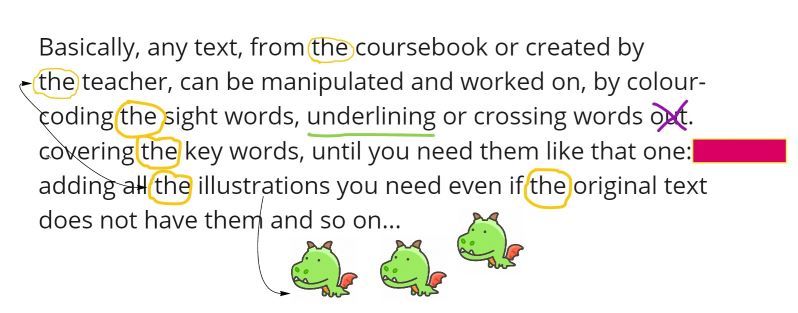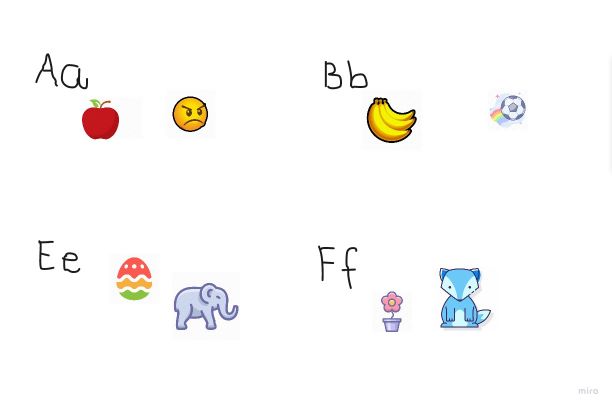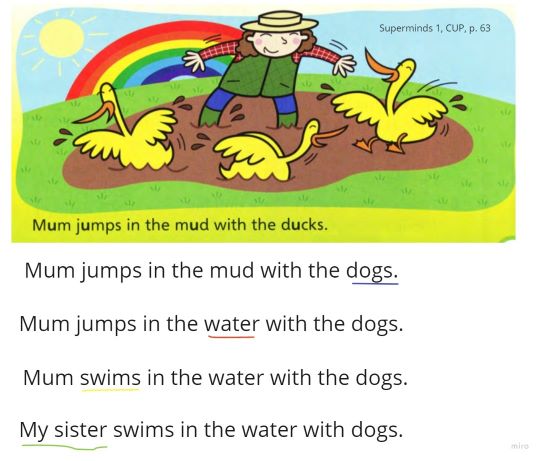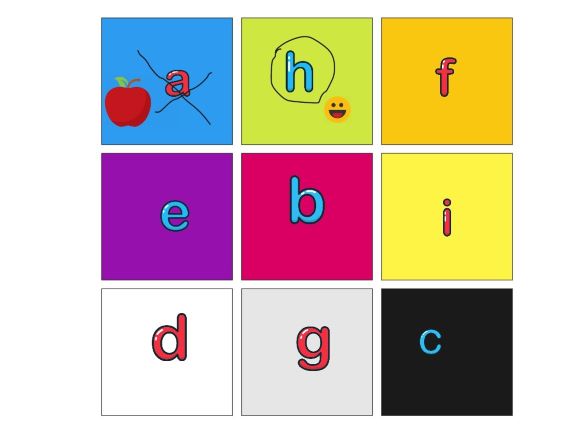Switching to the online and making it your place could be, in my case, described as flying colours or one step forward two steps back, on different days. Nothing wrong with that, a new reality, transitioning is a part of the game.
But, surprise surprise, I love teaching literacy online!
1. It is easier to get the kids focused.
2. It is easier to keep the whole group on the task.
3. Adapting activities to the requirements of the online classroom is not that difficult.
4. I have been forced to get interested in many apps, online games and programmes that I have, stubbornly, avoided so far.
5. We are improving and are better at reading.
The wonders of the Miro board, any level of literacy skills.

My Big (online) Book of Words: first letter level
It has been our tradition with all the pre-primary groups to start our class Big Book of Words where we collect all the words we know, gluing new cards (word+image) at the end of the unit and choosing a letter to read in every lesson as a part of our class routine. Since we’ve moved online, this little tradition had to be updated, too, but it was quite easy because on the miro board you can pick any image and quickly, too. Whatever word your students bring up, you’ve got it!

Noughts and crosses online: the first letter/sound level
It is one of my favourite games and so no wonder that there must have been a way to adapt it to the needs of early literacy and, then, to the needs of early literacy online.
The advantages are obvious: the older kids are familiar with the game and its rules and it tasks only a moment to prepare, online or off and you can easily focus on the chosen letters or phonics. With the older students in groups we play in teams, the kids choose the box and give a word that starts with that sound/letter. Some of them still struggle, that’s why each box contains not only a letter but also a number. This is what we use to choose.
With the younger kids, we keep the competitive element out, we use a bigger grid and we simply colour it in.
Phonics stories: sentence level
Before the kids get to read for real, they need to practice on simple phonics stories. They are inlcuded in every coursebook, some of them are more interesting, some are less but there is always a way of getting a little bit more of them. After a few rounds of listening and reading the story from the coursebook (‘Mum jumps in the mud with the ducks’) and then words in different order, the teacher does a sort of a ‘substitution drill’, revealing more and more sentences with one different word to really encourage them to read. The key words can be underlined, too.
This activity can be followed up by the students creating their own similar sentences and the teacher typing them up on the whiteboard.

Quizlet quiz: sentence level
Instead of putting single words and images or single words and translations, we use definitions. Students read them together and try to guess what it is. Then we check! To make it more challenging and to turn it into a real quiz, you can ask the kids to write the words and check at the very end, award points.Or not.
True or false: sentence level
It only takes an illustration, one of the pictures in the coursebooks or in the Cambrige YLE Wordlist Picturebook or anything else available online and a set of sentences that the teacher prepares beforehand.
They can be written on post-it notes or have them covered by shapes to be removed, one by one and ask the kids to react to the text. If the sentence is true – they clap their hands, if the sentences is false – they raise a hand.
The activity can be extended into a writing a activity, too. If nothing else, they can type them up into the chat box for the rest of the group to read and react.

Shared reading: text level
Shared reading was one of our favourite activities this year, until we had to move online. Doing it online is a bit challenging since not many storybooks are available online.
Online phonics stories like those from the youtube channel English Singsing https://www.youtube.com/watch?v=9C1qj06xduo&t=104s might be a solution but I have also started to use Barefoot Books, also on youtube https://www.youtube.com/watch?v=Lrd0TiER_J0. We use them with the sound switched off and at the lower speed. This and the bouncing ball really helps the kids to focus and to follow the text with ease.
Useful websites
- Phonics Bloom https://www.phonicsbloom.com/
- Oxford Owl https://www.oxfordowl.co.uk/for-home/find-a-book/library-page
- Starfall https://www.starfall.com/h/ltr-classic/
- Reading A – Z https://www.readinga-z.com/phonics/decodable-books/
- Kidz Phonics https://www.kizphonics.com/materials/

